Charles E. Burchfield (1893-1967)Volume 44, Page 15
December 3, 1941
cardboard notebook bound with string
8 1/2 x 11 inches
Gift of the Charles E. Burchfield Foundation, 2000
15. a few studies; to which he replied “Not a bit of it” – I then asked him to explain his method of plowing. He said his average “land” was ten paces (32 furrows as I later counted). Tho sometimes, if the need of drainage was not great, he used 12 or 14 paces. (I had counted, in a plowed field on my was, 64 furrows to a land, which would be 20 paces.) He gave a name to his “division” furrows, but I cannot recall what it was.
His method of plowing was a little different from what Bertha had described. Instead of starting at the edge of the land, and then going to the middle, he started in the middle, and then plowed up and down, gradually working out to the edge. The result was the same, but I though Berthas method would be a little easier, for he would not have to turn his horses out in the wide semi-circle, necessary on the first few furrows of his method.
I spent the whole day here, watching, listening, and absorbing plowing to the full (I have not done this enough of late years; - that is, studying in one spot, and experiencing one thing to the exclusion of all else, until it is completely absorbed. At the end of the day, I felt that I would never lose the impression + knowledge of plowing I had received.
The land was very wet, and as the rich brown earth was turned over, it was packed and smoothed by the plow-blade, so that it presented a highly polished wet glistening surface to the sunlight, reflecting it in a silvery glow, - (n.d.) gashes of deep brown


